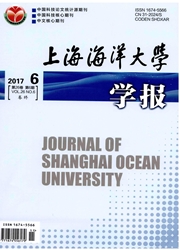

 中文摘要:
中文摘要:
用天然海水与海水晶配置成的人工海水按10:0,8:2,6:4,4:6,2:8,0:10的体积比配成6种不同的培养液,用它们培养野生型坛紫菜叶状体。培养30d后,叶状体的生长情况如下:在100%天然海水中培养的坛紫菜叶状体生长最快,其它组的生长快慢依次为:含20%〉40%〉60%〉80%的海水晶人工海水组。在100%海水晶人工海水组培养的叶状体5d后死亡。叶状体叶绿素α(Chl.α)含量在20%海水晶人工海水组中最高,其余各组的含量相差不大,但藻红蛋白(PE)和藻蓝蛋白(PC)含量均比100%天然海水组稍低。用上述6种培养液培养坛紫菜丝状体,结果表明在60%海水晶人工海水组中培养的自由丝状体鲜重增加最明显,生长情况最好,100%天然海水组增重最少,其余各组增重差异不明显。坛紫菜丝状体在100%海水晶人工海水中生长良好,这说明可以用海水晶人工海水来培养坛紫菜丝状体。
 英文摘要:
英文摘要:
The young gametophytic blades of the wild type in Porphyra haitanensis were cultured respectively in different culture solutions which were composed of nature seawater and artificial seawater in different proportions ( 10 :0, 8:2,6:4,4:6,2:8,0: 10), and being enriched with MES medium. After 30 days of culture, the growth of the blades was the fastest in 100% natural seawater, and the growth speed in the others was 20% 〉 40% 〉 60% 〉 80% of seawater crystal, respectively. However, the blades cultured in 100% seawater crystal died after 5 days. The content of chlorophyll a (Chl. a) was highest in the blades cultured in 20% seawater crystal, and no obvious differences in the content of Chl. a were found in the blades cultured in other culture solutions, while the contents of phycoerythrin and phycocyanin in the blades were a litter lower than those of the blades cultured in the 100% seawater. The free-living conchocelis of Porphyra haitanensis were cultured in the above six kinds of culture solutions. After five weeks of culture, the increase of the wet weight of the free-living conchocelis cultured in 60% seawater crystal was most significant, but least increase of wet weight appeared in conchocelis cultured in 100% natural seawater. The weight increase of conchocelis cultured in other culture solutions did not show significant differences. The free-living conchocelis of P. haitanensis grew well in 100% of seawater crystal, indicating that its conchocelis can be cultured in 100% of seawater crystal.
 同期刊论文项目
同期刊论文项目
 同项目期刊论文
同项目期刊论文
 Genetic analysis of the position of meiosis in Porphyra haitanensis Chang et Zheng (Bangiales, Rhodo
Genetic analysis of the position of meiosis in Porphyra haitanensis Chang et Zheng (Bangiales, Rhodo 期刊信息
期刊信息
